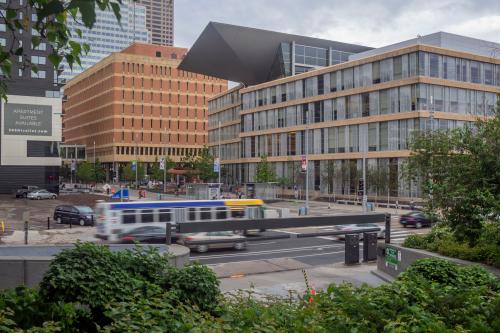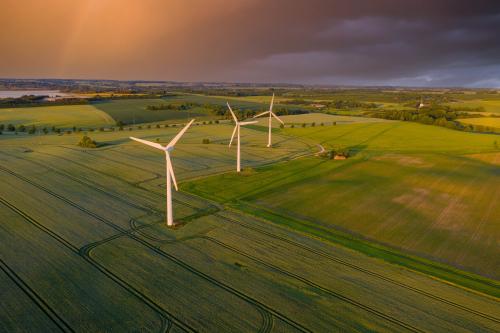From wildfires and droughts in the West to surging rainfall in the East, this summer has offered steady evidence of just how destructive climate change can be. Now, with grim new findings from the latest UN climate report—including higher pollution, higher temperatures, and higher sea levels—we also have more evidence that these kinds of acute and chronic events will only grow over the coming years. Environmental damage and insecurity are here now, but we should expect environmental, health, and economic costs to multiply for generations to come.
Yet amidst all the gloom, it’s easy to overlook the co-benefits we could capture by protecting ourselves and the planet. Reducing greenhouse gas emissions can improve health and safety. Greater resilience in the face of extreme storms and other chronic climate challenges, including flooding, can improve property values. Investing in cleaner technologies and other physical upgrades can create millions of jobs and grow American industries, as the Biden administration and other policymakers have touted as part of a recent federal infrastructure push.
The challenge is that it’s still hard to precisely measure climate-related costs and benefits. The enormous geographic scale and variety of climate impacts can be difficult to model locally, and consistently monitoring these impacts requires years of testing and evaluation. Instead, communities frequently react to climate threats in real time, absorb the damage, and struggle to pioneer new solutions. Benefits do not materialize, and the vicious cycle of destruction repeats itself. Even though local leaders directly manage major sources of climate change (polluting roads and land uses, for instance) and are the first responders to events like storm surges, they still fail to systematically account for the costs they need to reduce, the benefits they hope to achieve, and the ultimate climate improvements they need to carry out.
If we want to address our current haphazard, reactionary approach to climate change, better local accounting of climate costs and benefits is crucial.
Transportation officials, water utility executives, land use planners, and property developers are among the wide range of local leaders who construct and manage our built environment amid rising climate threats—and they often fail to account for these threats. They keep building and buying many of the same types of infrastructure that contribute to increased pollution, rising temperatures, and other impacts. For example, continued road expansions and sprawling development offer immediate solutions to immediate needs, but expose us to greater risks over time.
As a result, the costs of climate events are mounting while many local leaders remain more focused on recovery than resilience, or boosting the capacity of our communities to survive and thrive in a more extreme, uncertain climate. Rather than spending extra time and money upfront to pursue new types of infrastructure projects (which may also require familiarity with new technologies and designs), local leaders may opt for familiar projects and rely on traditional planning approaches. The lack of technical and financial flexibility limits local experimentation with projects that can better protect our communities in the short and long term. Then, when disaster hits, local leaders look to the Federal Emergency Management Agency (FEMA) and other federal recovery assistance as a first resort, not a last resort. This reactive approach results in more costs—destroyed homes, polluted air, inundated roads, and lost jobs—and signals a need to better measure and mitigate costs in advance.
While measuring these costs matters to address a changing climate, local leaders also need to identify and evaluate the benefits of making more proactive climate investments. Doing so can help us better adapt to our worsening climate reality, boost the reliability and performance of our existing infrastructure systems, and motivate our political will and appetite to invest sooner rather than later.
Communities vary widely in the types of infrastructure improvements they need and the associated benefits they could realize, but local leaders should better define the types of projects at stake and the types of returns on investment. For example, distributed electric grids, permeable roads, sea walls, rain gardens, and green roofs are among the many innovations and designs that offer greater flexibility and protection amid a changing climate. These and other types of climate projects can lead to benefits such as:
- Increased resource efficiency. Reuse technologies and designs used by energy and water utilities—including closed-loop cooling systems and bioretention facilities—can conserve resources and boost efficiency. Trees, green roofs, and other natural infrastructure can lead to cooler conditions (which improve energy use) and better absorb and manage stormwater.
- Increased property values. Being less exposed to acute and chronic climate events provides greater certainty to developers and property owners, leading to higher housing and neighborhood values. Improved aesthetics and greenery—including native landscaping, rain gardens, and other green infrastructure upgrades—can also improve the value of nearby buildings.
- Increased recreation. Proximity to parks, rivers, and other green infrastructure facilities offers a public amenity to residents, businesses, and visitors. This supports physical activity, public health, community engagement, and other recreational opportunities.
- Increased workforce and industry development. Constructing and maintaining infrastructure—including green infrastructure—not only has the potential to create more local, direct jobs in the short term, but also can support ongoing opportunities to educate, train, and engage prospective workers. At the same time, additional research and development activities and business opportunities around new climate-friendly products and processes can power industrial growth and lead to more jobs.
Since these costs and benefits are so diffuse, it can be difficult to identify, measure, or translate impacts across different types of infrastructure and regions. While some researchers are exploring these impacts, no single entity has ownership of this challenge. It’s time to treat climate accounting with the same seriousness we do other essential economic indicators like employment and industrial output.
A better measurement regimen starts with more routinized measurement of costs and benefits across multiple infrastructure systems and multiple regions, as researchers at the Natural Capital Project, Urban Infrastructure Lab, and elsewhere have explored. Rather than emphasizing cheaper, more familiar projects with lower upfront costs, local leaders should better articulate and act on the climate objectives and benefits they hope to achieve through more forward-looking projects. For instance, how do current capital improvement plans incorporate climate outcomes? Who is responsible for analyzing and evaluating climate outcomes? While local governments vary widely in their technical, financial, and staffing capacity to carry out such efforts, they need to start prioritizing and judging infrastructure projects based on their ability to reduce climate costs and increase climate benefits.
With more routinized measurements, local leaders can more easily identify the types of projects that deliver the biggest returns on investment. Ad-hoc improvements on one property or in one neighborhood are helpful, but researchers, planners, and policymakers can struggle to evaluate the impacts of such one-off projects. Instead, we need to recognize that costs and benefits result from many different projects and occur at many different geographic levels—and that ideally, we’re striving to test projects with multiple benefits that connect at a regional level. For instance, greenways (connected corridors and shared-use paths that typically preserve open space and vegetation) can boost transportation access, improve air quality, and manage stormwater runoff. The enormous co-benefits of these projects can cross multiple jurisdictions and lead to regional, systemwide improvements to health, safety, and sustainability for all residents.

Geographic scale of climate-related infrastructure investments
Examples of projects with multiple benefits are starting to emerge at a regional level. For instance, the city of Los Angeles and the University of Southern California have piloted an Urban Trees Initiative that supports a larger citywide effort to plant 90,000 trees and increase the tree canopy in “low-income heat zones” by 50%. By focusing on the reduced costs and increased benefits of tree canopy cover (reduced urban heat island effects and increased property values, for instance), leaders are attempting to target investments in areas that will minimize regional costs, maximize regional benefits, and generate a larger return on investment.
By testing and evaluating new types of infrastructure improvements, local leaders can begin to see more widespread, demonstrated benefits and reduced costs from climate improvements. And with more regional cases to justify future investments, federal, state, and local leaders can consistently carry out more resilient infrastructure improvements across the country. However, this process is only just beginning in a few regions and will take time to ramp up. It is also unclear how local leaders can begin to share common lessons and definitions with each other, let alone settle on any common, agreed-upon costs and benefits that come from climate investment.
But better accounting of local climate costs and benefits is an essential starting point to improve our infrastructure, build greater resilience, and take more proactive climate action. Better local accounting is also essential to scale future climate investments across the country; without a clear understanding of where urgent climate risks exist or where benefits could be achieved locally, we lack the precise measures to target needed infrastructure improvements. Forthcoming Brookings research will explore these scalable investments in greater depth.







Commentary
Taking climate action demands better local accounting of costs and benefits
August 18, 2021